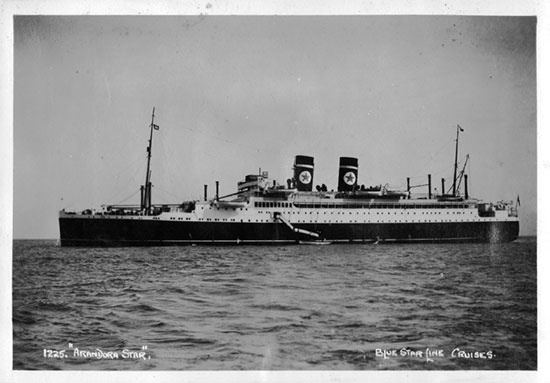Sinking of the SS Arandora Star, July 2, 1940
Historical Context
On June 10th 1940 Benito Mussolini, Prime Minister of the Kingdom of Italy officially declared his country’s alliance with Nazi Germany. Italy was at war with Great Britain and its allies.
| The attached XLS spreadsheet details the souls lost on the SS Arandora Star with a direct Barga connection. The PDF is a slide-presentation showing photos and profiles of many from the Barga area who perished in the attack. | |
|---|---|
| The same presentation, with musical accompaniment, is available on YouTube. | |
This action sparked a chain of events which were to prove disastrous for the fate of many Italian nationals residing in the United Kingdom. Until then the thousands of Italians who had immigrated to the UK during the previous 50 plus years lived a peaceful and healthy existence.
It’s clear that there were many Italians in the UK who openly approved of Mussolini’s domestic and foreign policies. But for the majority it was nothing more than enthusiastic patriotism and love for motherland Italy. The symbol of fascism, a bundle of rods meant to signify that group identity was stronger than the individual, was a convenient excuse for Italians to re-explore their Italianita, their Italian-ness. It was about the rebirth of the Italian soul, about socialising over a plate of pasta, about playing cards together and encouraging their children to learn Italian properly and perhaps even finding fellow Italian spouses.
| In July 2020 the local newspaper in Barga "il Giornale di Barga" published an article commemorating the 80th anniversary of the sinking of the SS Arandora Star which features research by BGRG members. |
In spring 1940 Great Britain was its lowest ebb. The Nazis were all conquering throughout mainland Europe and indeed were threatening an invasion. Only in the previous weeks the country had mounted a huge effort to rescue thousands of weary soldiers from the beaches at Dunkirk. The Nazis were winning and Mussolini’s lofty ambitions to expand his empire and perhaps inherit British colonies in Africa and elsewhere sealed his decision. His country would be siding with the Nazis.
All the while the British government was preparing themselves. They were viewing the Italian community in the UK as a ‘fifth column’ from within, supporters of Nazi Germany, which could eventually spell disaster for the country. Winston Churchill’s infamous ‘Collar the Lot’ speech in parliament paved the way for a complete sweep of virtually every male Italian over the age of 16. Within 24 hours of Mussolini’s declaration, virtually every Italian male across the land was arrested and later interned in work camps. Some were shipped to Canada, some were shipped to Australia and some interned on the Isle of Man awaiting deportation to the extremities of the British Empire. Amid riots and sporadic violence against Italian businesses on the night of 10th June wives and children were ruthlessly left behind to fend for themselves while the breadwinners were taken.

An Ill-fated Journey
It was on the SS Arandora Star on the fateful evening of 1st July 1940 that a ship load of Italians, Germans, Austrians and Jews departed Liverpool on their way to Canada. For reasons still unknown the ship has no Red Cross insignia, and a single machine gun visible on the stern of the battle grey ship indicated to the Nazis that perhaps this was more than a ship transporting impoverished prisoners.
A Nazi submarine U-47 was lying in wait off the course of Ireland. Its commander, Gunther Prien was experienced. A few months previously he had sunk HMS Royal Oak at Scapa Flow where over 800 British service men lost their lives. Prien was ambitious, he wanted one last strike before returning to base for a torpedo reload. The Arandora Star was his final target and he scored a direct hit. Out of around 1,700 on board, over 900 lost their lives of which about 450 were Italians. Aged between 16 and 70 the majority of the Italians owned small Ice Cream cafes or Fish and Chip shops or worked as chefs and waiters, hardly the breeding ground for infiltrators of the state.
There were 14 known victims born within the parishes of Barga and at least another 4 to 6 others with very close family links to Barga. In addition there were the same number of victims again born in Garfagnana, Castelnuovo, Pieve Fosciana, Camporgiano and elsewhere in the province of Lucca. Few regions in Italy were left unscarred by the tragedy.
The nonnas, wives and children left behind at home knew nothing of the tragedy for months. This wasn’t peacetime. Great Britain was in an extremely weak position. News of the disaster would weaken further morale of the nation. So a strict silence and news ban was maintained.
Meanwhile a Canadian destroyer managed to rescue hundreds. For those who perished they had to wait until their bodies washed ashore. It was 4 weeks before the first body washed ashore on the Irish coast. During August over a 100 bodies made it to shore. Some were capable of being identified, others not. These were very dismal days indeed in the history of Britain’s maritime history.
The attached spreadsheet details the souls lost with a direct Barga connection.
July 2020 will be the 80th anniversary of the SS Arandora Star tragedy. Let us never forget!
Roberto